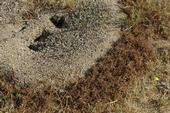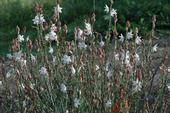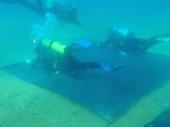- Author: Carl E. Bell
- Posted by: Gale Perez

While conducting a field experiment testing herbicides for control of sahara mustard in Borrego Springs in 2011, out of a corner of my eye I saw a ring of rusty brown around an ant hole.
Being curious I looked closer. It was an organized mound that was maybe 1 inch high and 3 inches across of redstem filaree (Erodium cicutarium) fruit. It was exclusively filaree, nothing else.
So I explored a little more on my knees and saw these small black ants a foot or so away on a well-beaten trail. Most of the ants had a filaree fruit in its mouth. I don't know the species of ant, but a quick Google search suggests that it is a species of...
- Reposted by: Gale Perez
- Author: Carl E. Bell

Onionweed (Asphodelus fistulosus) is an attractive but very difficult to control weed that is relatively common along highways, some irrigation right of ways and other areas in Southern California. It likely came to our area as an ornamental plant, maybe as part of a seed mix or used (I was told) in reclamation projects in the north county area of San Diego. Once you learn to recognize it, it is easy to spot in spring and summer, especially along interstate 5 from La Jolla and on north at least as far as San Luis Obispo County. Photo 2 is from a restoration site in San Diego...
- Author: Joe DiTomaso
- Author: Tom Barr

Aquatic weed propagules pose a serious long-term management problem. Curlyleaf pondweed (Potamogeton crispus) produces numerous asexual propagules that make traditional management difficult. We initially compared the effect of three benthic barrier materials (jute, polyethylene and rubber) on the control of curlyleaf pondweed turions (see Fig. 1 for example of bottom barriers) in both laboratory bench studies and studies using larger mesocosms. After the bottom barriers covered the turions for eight weeks we then determined the viability of the turions by allowing them to sprout. Our results showed that the jute and polyethylene did not give any control of curlyleaf pondweed sprouting, but the rubber barrier, which blocks both...
- Author: Rob Wilson
Happy New Year! It’s too cold in Tulelake for field work, so I’m busy summarizing 2013 research results. Today I posted a progress report on the Intermountain Research and Extension Center (IREC) website summarizing results for our 2013 onion weed control research. The study was conducted at IREC to evaluate rates of DCPA (Dacthal) alone and combined with pendamethalin (Prowl H20) applied at loop stage for control of kochia in onions grown on silty clay soil with high organic matter. Sulfentrazone (Zeus), an unregistered herbicide in onions, was tested at various rates as a preemergence and postemergence herbicide on the same soil type. Prowl H20 application timing was also evaluated by comparing applications...
- Author: Lynn M. Sosnoskie
- Author: Brad Hanson
- Author: W Thomas Lanini
Introduction:
According to the most recent statistics, the United States (US) was the world's sixth largest producer of melons, with a significant proportion (>50%) of the country's production occurring in California. In 2011, 36,900 and 10,300 acres of cantaloupes and honeydews were harvested, respectively. Combined, the crops were valued at an estimated $227 million, which is an increase of 29% over 2010.
Weed control in melons is difficult due to the vining nature of the crop (which can prohibit mechanical cultivation) and the limited availability of safe and selective preemergence (PRE) and postemergence (POST) herbicides. Early-season weed control is crucial in order to prevent competitive...


